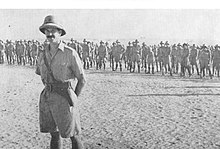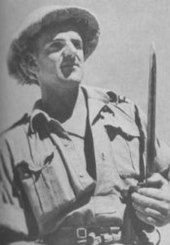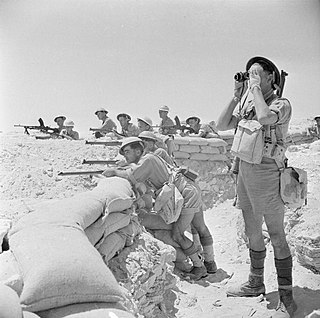
The First Battle of El Alamein was a battle of the Western Desert campaign of the Second World War, fought in Egypt between Axis forces of the Panzer Army Africa—which included the Afrika Korps under Field Marshal Erwin Rommel—and Allied forces of the Eighth Army under General Claude Auchinleck.
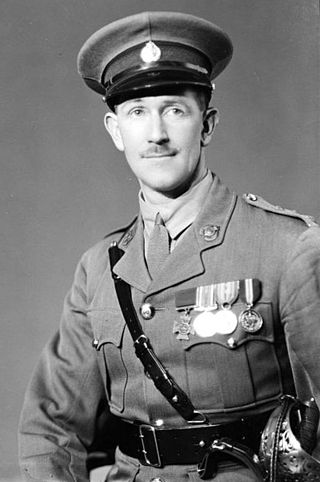
Brigadier Leslie Wilton Andrew, was a senior officer in the New Zealand Military Forces and a recipient of the Victoria Cross, the highest award of the British Commonwealth for gallantry "in the face of the enemy". He received the decoration for his actions during the Battle of Passchendaele in 1917.

The 2nd New Zealand Division, initially the New Zealand Division, was an infantry division of the New Zealand Military Forces during the Second World War. The division was commanded for most of its existence by Lieutenant-General Bernard C. Freyberg. It fought in Greece, Crete, the Western Desert and Italy. In the Western Desert Campaign, the division played a prominent role in the defeat of German and Italian forces in the Second Battle of El Alamein and the British Eighth Army's advance to Tunisia.

The military history of New Zealand during World War II began when New Zealand entered the Second World War by declaring war on Nazi Germany with the United Kingdom in 1939, and expanded to the Pacific War when New Zealand declared war on Imperial Japan following the attack on Pearl Harbor in 1941.
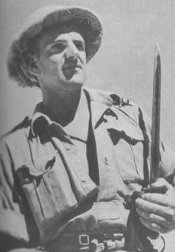
Keith Elliott, VC was a New Zealand soldier who served with the New Zealand Military Forces during the Second World War. He was awarded the Victoria Cross, the highest award for gallantry in the face of the enemy that can be awarded to British and Commonwealth forces, for his actions in the First Battle of El Alamein.

The 28th (Māori) Battalion, more commonly known as the Māori Battalion, was an infantry battalion of the New Zealand Army that served during the Second World War.

Major General Sir Howard Karl Kippenberger,, known as "Kip", was an officer of the New Zealand Military Forces who served in the First and Second World Wars.

The 2/1st Battalion was an infantry battalion of the Australian Army. Formed as part of the Second Australian Imperial Force at the start of World War II, the battalion was deployed to the Middle East in early 1940 and subsequently took part in the early fighting in the North African campaign, taking part in battles around Bardia and Tobruk before later being sent to Greece in early 1941. A lightning German advance quickly pushed the Allies back and forced them to evacuate after a very short campaign and the 2/1st was landed on Crete where they subsequently fought unsuccessfully to repel a German invasion in May. The majority of the battalion was captured on Crete, but the 2/1st was subsequently re-built from survivors in Palestine and returned to Australia in early 1942 following Japan's entry into the war. They then fought two campaigns against the Japanese in New Guinea, fighting in the Kokoda Track campaign during 1942–43 and the Aitape–Wewak campaign in 1944–45. Following the war, the 2/1st was disbanded.

The 2/2nd Battalion was an infantry battalion of the Australian Army raised for service as part of the all-volunteer Second Australian Imperial Force during World War II. Raised in October 1939, the battalion was deployed to the Middle East and in early 1941 took part in the first ground action undertaken by Australian troops during the war during the Battle of Bardia before helping to capture Tobruk. In April, the battalion briefly fought in Greece, before being evacuated after the Allied forces were overwhelmed by German forces. Some members of the battalion took part in the Battle of Crete, after which the battalion undertook garrison duties in Syria. In mid-1942, the 2/2nd undertook defensive duties in Ceylon before returning to Australia. They subsequently took part in the fighting against the Japanese along the Kokoda Track and then around Buna–Gona. After a period of reorganisation and training in Australia throughout 1943–44, late in the war the battalion was committed to the Aitape–Wewak campaign before being disbanded in early 1946 after the war.

The Divisional Cavalry Regiment was an armoured cavalry regiment of the 2nd New Zealand Division during the Second World War and was New Zealand's first armoured unit. It served as a reconnaissance force for the 2nd New Zealand Division. Formed on 29 September 1939, the regiment embarked for Egypt on 4 January 1940. It fought with the division, as part of the 2nd New Zealand Expeditionary Force, in Greece, Crete, North Africa and Italy. The regiment formed part of J Force, New Zealand's contribution to the occupation of Japan at the end of the war.

The 27th Machine-Gun Battalion was a unit of the 2nd New Zealand Division during the Second World War. It served in the Greek Campaign, Western Desert Campaign, Tunisian Campaign, Italian Campaign and after the war took part in the Occupation of Japan. It was one of two New Zealand formations that served overseas longer than any other unit in the New Zealand Expeditionary Force. The battalion was also one of the New Zealand units that supplied men for the Long Range Desert Group.
The 23rd Battalion, also known as the Canterbury-Otago Battalion, was an infantry battalion of the New Zealand Military Forces during the Second World War. Formed in November 1939 as part of the 5th Brigade, 2nd Division of the 2nd New Zealand Expeditionary Force. After undertaking training at Burnham Camp the battalion sailed from New Zealand on 1 May 1940. The battalion saw action in Greece, Crete, North Africa, and Italy.
The 21st Battalion was an infantry battalion of the New Zealand Military Forces that served during the Second World War. Formed in January 1940, it was part of the 5th Brigade, 2nd New Zealand Division of the 2nd New Zealand Expeditionary Force. The battalion saw action in Greece, Crete, North Africa and Italy before it was disbanded in December 1945.

The 20th Battalion was a formation of the New Zealand Military Forces which served, initially as an infantry battalion and then as an armoured regiment, during the Second World War as part of the 2nd New Zealand Division.
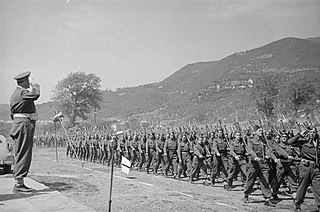
The 5th Infantry Brigade was an infantry brigade formation of the New Zealand Military Forces, active during World War II as part of the 2nd New Zealand Division. It saw service during the Battle of Greece, the Battle of Crete, the North African Campaign and the Italian Campaign before being disbanded in late 1945.

The 19th Battalion was a formation of the New Zealand Military Forces which served, initially as an infantry battalion and then as an armoured regiment, during the Second World War as part of the 2nd New Zealand Division.

The 18th Battalion was a formation of the New Zealand Military Forces which served, initially as an infantry battalion and then as an armoured regiment, during the Second World War as part of the 2nd New Zealand Division.

The 24th Auckland Battalion was an infantry battalion of the New Zealand Army during the Second World War. The 24th Battalion was formed on 1 February 1940 and embarked for Egypt on 28 October 1940. It was part of the 6th Infantry Brigade, part of the 2nd New Zealand Division. The battalion fought in Greece, North Africa and Italy. After the conclusion of hostilities, the battalion was disbanded in December 1945.

The 25th Battalion was an infantry battalion of the New Zealand Military Forces, which served during the Second World War as part of the 6th Infantry Brigade, 2nd New Zealand Division.
The 26th Battalion was an infantry battalion of the New Zealand Military Forces, which served during the Second World War as part of the New Zealand 2nd Division. Raised in May 1940, it fought in the Battle of Greece, the North African Campaign and the Italian Campaign. It finished the war in Trieste and was disbanded in December 1945.
